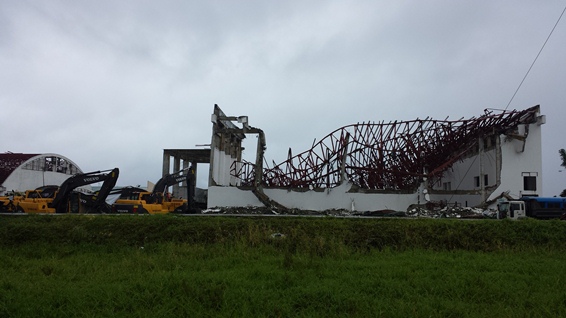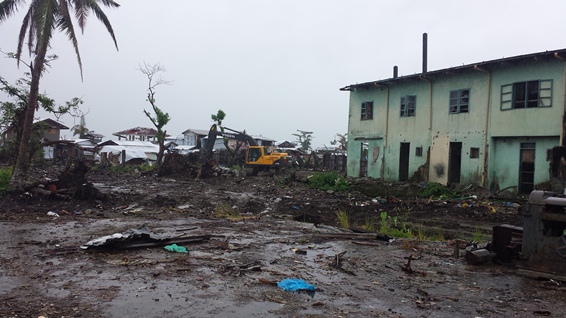Typhoon Haiyan relief effort accelerated by Volvo CE donation

Typhoon Haiyan struck the central part of the Philippines archipelago on November 8, 2013. The two-day storm generated winds of over 195mph and a 12-foot storm surge that ripped through Tacloban City – the most populous area of Eastern Visayas – resulting in the loss of 6,000 lives and completely destroying over 500,000 homes.
Immediate response from the Philippine Army and international aid organizations initiated a mass clean-up operation to remove the debris that was piled over 10-foot high and moved to temporary dump sites around Tacloban City. In January, two months on from the most powerful storm ever recorded, the temporary dump sites were decaying and creating a health hazard to the thousands of inhabitants that had been moved into nearby temporary accommodation.
 The government of the surrounding province of Leyte launched an appeal for heavy-equipment to clear the temporary dumps, and Volvo Construction Equipment (Volvo CE) and its Philippine dealer network, Civic Merchandising Inc., were quick to act – mobilizing 15 brand new EC210 B-Series excavators and 15 experienced machine operators for immediate use. Ten of the units arrived in January and were immediately put to work by the Philippine Department of Public Works and Highways (DPWH), while a further five units were deployed in February for use by the United Nations Development Programme (UNDP).
The government of the surrounding province of Leyte launched an appeal for heavy-equipment to clear the temporary dumps, and Volvo Construction Equipment (Volvo CE) and its Philippine dealer network, Civic Merchandising Inc., were quick to act – mobilizing 15 brand new EC210 B-Series excavators and 15 experienced machine operators for immediate use. Ten of the units arrived in January and were immediately put to work by the Philippine Department of Public Works and Highways (DPWH), while a further five units were deployed in February for use by the United Nations Development Programme (UNDP).
Improving long term sanitation
A total of 500,000 cubic meters of debris had to be cleared from Tacloban City’s center and hauled to municipal waste sites in the surrounding suburbs. “When we heard from Volvo CE’s dealer, Civic Merchandising, that we could use the excavators free of charge, we were elated,” explains Dr. Tim Walsh, Waste Management Specialist, UNDP. “The heavy equipment was essential for moving all the debris – and without this donation, we would have had to rent the units, costing a great deal. Thanks to Volvo, we’ve been able to use this money in rehabilitation projects elsewhere.”
 The Volvo CE excavators will now be used to upgrade the municipal landfill sites into Controlled Landfills – meaning that groundwater is protected from contamination from the liquid waste that seeps into the ground. This is achieved by inserting a liner – soil or synthetic – and a leachate collection and treatment system into the landfill site to stop contaminants entering the water table.
The Volvo CE excavators will now be used to upgrade the municipal landfill sites into Controlled Landfills – meaning that groundwater is protected from contamination from the liquid waste that seeps into the ground. This is achieved by inserting a liner – soil or synthetic – and a leachate collection and treatment system into the landfill site to stop contaminants entering the water table.
“Our aim is to leave the municipal dumps in a better state than we found them in order to improve sanitation and ground water,” Walsh says. “The sites have been receiving more than 300 truckloads of waste a day for months, when they’re only designed to take about 20. They are overfilled and under-prepared to handle such quantities. But by addressing the environmental and health concerns that surround the way waste is being disposed of, we can leave Tacloban City with better waste management facilities for the future.”
The excavators will also be put to work demolishing the city’s convention center and other buildings that have been left structurally unstable by the storm. Geologist and Disaster Waste Manager for the UNDP, Thorsten Kallnischkies, says: “Demolition is a dangerous job. Buildings can easily collapse if they’re not deconstructed in a managed way – and this puts lives at risk. We need experienced machine operators, such as those Civic Merchandising provided, to demolish the buildings in a safe and controlled manner.”
A heart-warming response
The phrase “I ♥ Tacloban” can be seen all over the city – on every bus stand that remains in-tact; on every jeepney (the local public bus service) and on the side of every tuk-tuk (rickshaw-like taxis). A population that is obviously very proud of its heritage and famous for its optimistic personality, the local people have made an overwhelming contribution towards the city’s rehabilitation through the UNDP’s Cash for Work scheme – which offers local residents the opportunity to earn money to clear debris from communal areas across the city, including hospitals and schools.
“When citizens lose family members, their homes and their livelihoods in a disaster such as Typhoon Haiyan, they don’t know how to begin rebuilding their lives,” explains Walsh, who has visited many post-disaster zones during his career. “The UN’s Cash for Work scheme gives people structure and direction, allowing them to contribute towards the recovery of their own city. By earning money, they are able to buy their own food and not rely on hand-outs – and it helps to take their minds off the trauma they’ve been through.”
The UN is among many aid organizations and charities from around the globe that have helped in the initial stages of the relief operation. With essentials such as running water, food and electricity now reinstated – efforts turn towards rebuilding an entire region’s housing and industry. The appreciation of this global relief effort can be seen all over Tacloban – with banners and messages of thanks displayed all over the city. “We never knew we had so many friends around the world until this disaster happened,” comments one local citizen.
Ends.
Text: Holly Brace
March 2014
For further information, please visit: www.volvoce.com/press
Or contact:
Mats Edenborg
VP, APAC Corporate Communications
Volvo Construction Equipment
Tel: +65 6412 2804
Email: mats.edenborg@volvo.com
Holly Brace
SE10
Singapore
Tel: +65 9724 4871
Email: holly.brace@se10.com